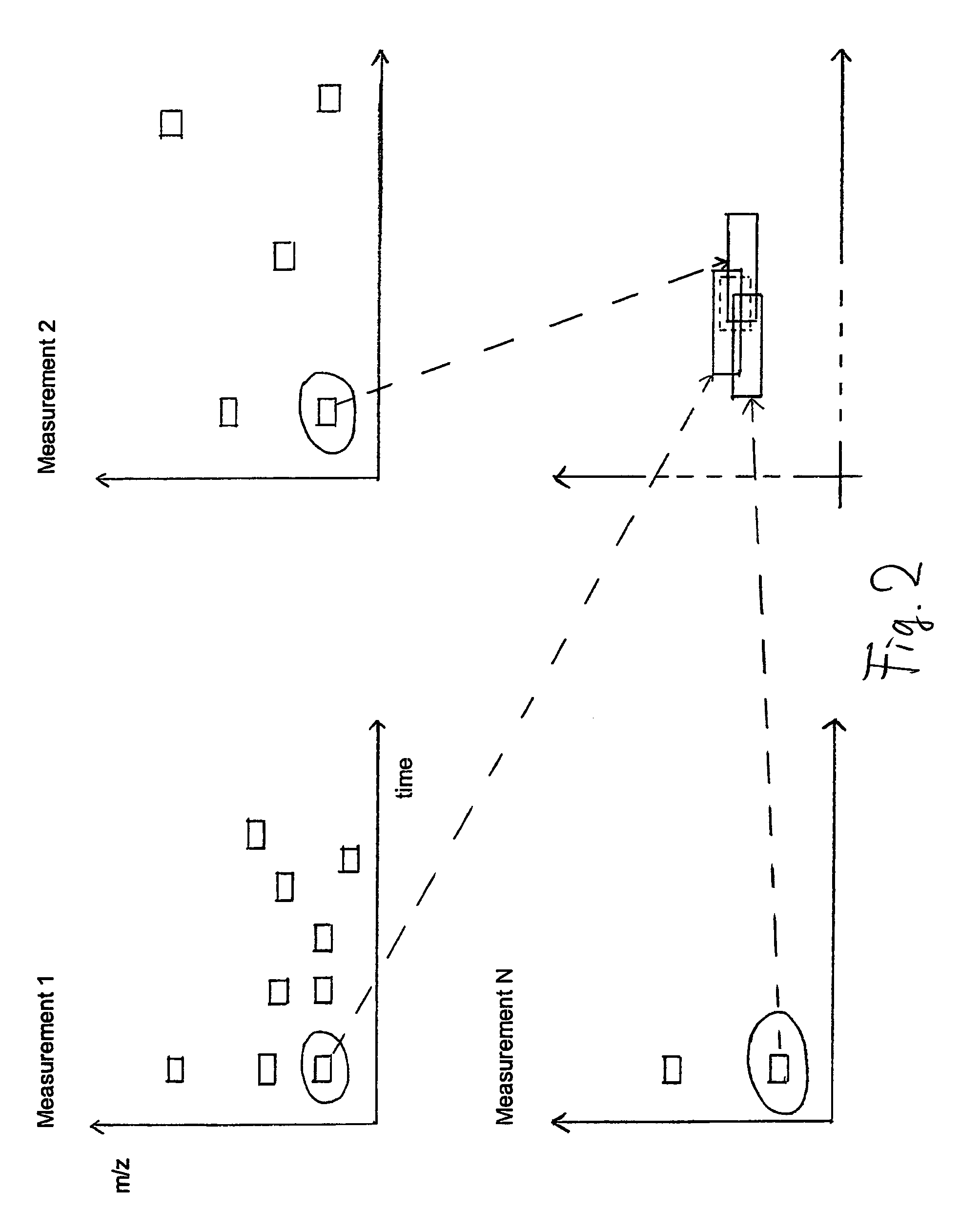Method and system for processing multi-dimensional measurement data
a multi-dimensional measurement and data processing technology, applied in particle spectrometer methods, instruments, material analysis, etc., can solve the problems of reducing the possibility of finding and affecting the effect of pattern recognition analysis
- Summary
- Abstract
- Description
- Claims
- Application Information
AI Technical Summary
Benefits of technology
Problems solved by technology
Method used
Image
Examples
embodiments
[0461]As indicated, according to a preferred embodiment of the method, generally several samples are analyzed, namely blank samples, samples including only standards, real samples, calibration samples and real samples including internal standards. With reference to one real sample at least one associated standard measurement and at least one associated blank measurement should be used as basis for the initialization of the grouping with respect to the measurement data obtained from the real sample. Accordingly, first the measurement data for the blank sample and the standard sample have to be obtained before the grouping for the real sample is started. However, it should not be ruled out, that the data preprocessing and processing is effected globally with respect to a data set including all measurement data for said samples. Further, it should not be ruled out, that a data preprocessing and data processing is already effected simultaneously in course of effecting the techniques pro...
example
[0521]The data preprocessing and data processing in its various aspects was applied to an LC-ESI-MS set of data of a serum sample. By denoising, spike identification, deleting the sequence of the mobile phase and the internal standards and grouping the peaks into variable bins a new set of data was generated which keeps the complete relevant information about position and intensity of the “real” peaks while considerably reducing the amount of data. The raw data included about three million single data points, corresponding to an amount of data of about 22 MB. After the preprocessing and processing 1087 peaks remained, corresponding to an amount of data of about 700 kB. Accordingly, a considerable data reduction and compression was obtained, although all information was maintained which is needed for characterizing the sample with respect to constituents included therein.
[0522]FIG. 25 is a comparison of a three-dimensional representation of a LC-MS data set before (FIG. 25a; raw data...
numerical example
[0523]With reference to FIG. 26, which shows a diagram representing a peak found by grouping in a large LC-MS raw data set and with reference to a grouping protocol shown in FIGS. 27 to 78, in which protocol data representing the grouping underlying the grouping result according to FIG. 26 are included, a preferred embodiment of the grouping is further illustrated. FIGS. 27 to 78 represent an excerpt from the grouping protocol having many grouping protocol pages.
[0524]In an introductory portion 10 of the grouping protocol, on grouping protocol page 1 of FIG. 27, some parameters are given, on which the grouping is based. Important parameters are an intensity cutoff threshold, an unimodality cutoff threshold and a kurtosis cutoff threshold. In sections 12 and 14 of the protocol the type of prior distribution assumed and initialization data for the Bayesian statistics are given.
[0525]For reasons of simpler data processing, not the whole mass-to-charge axis is considered at once when sc...
PUM
| Property | Measurement | Unit |
|---|---|---|
| mass | aaaaa | aaaaa |
| mass | aaaaa | aaaaa |
| mass | aaaaa | aaaaa |
Abstract
Description
Claims
Application Information
 Login to View More
Login to View More - R&D
- Intellectual Property
- Life Sciences
- Materials
- Tech Scout
- Unparalleled Data Quality
- Higher Quality Content
- 60% Fewer Hallucinations
Browse by: Latest US Patents, China's latest patents, Technical Efficacy Thesaurus, Application Domain, Technology Topic, Popular Technical Reports.
© 2025 PatSnap. All rights reserved.Legal|Privacy policy|Modern Slavery Act Transparency Statement|Sitemap|About US| Contact US: help@patsnap.com



